中国文化典籍英译
24部中国名著英语翻译大全
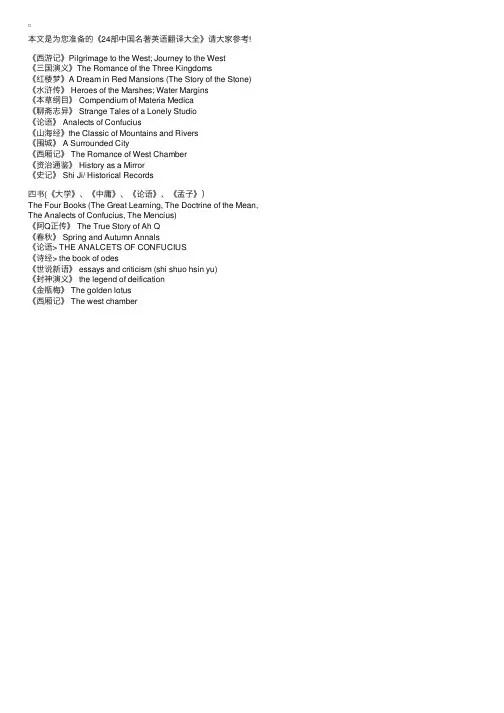
本⽂是为您准备的《24部中国名著英语翻译⼤全》请⼤家参考!《西游记》Pilgrimage to the West; Journey to the West《三国演义》The Romance of the Three Kingdoms《红楼梦》A Dream in Red Mansions (The Story of the Stone)《⽔浒传》 Heroes of the Marshes; Water Margins《本草纲⽬》 Compendium of Materia Medica《聊斋志异》 Strange Tales of a Lonely Studio《论语》 Analects of Confucius《⼭海经》the Classic of Mountains and Rivers《围城》 A Surrounded City《西厢记》 The Romance of West Chamber《资治通鉴》 History as a Mirror《史记》 Shi Ji/ Historical Records四书(《⼤学》、《中庸》、《论语》、《孟⼦》)The Four Books (The Great Learning, The Doctrine of the Mean, The Analects of Confucius, The Mencius)《阿Q正传》 The True Story of Ah Q《春秋》 Spring and Autumn Annals《论语> THE ANALCETS OF CONFUCIUS《诗经> the book of odes《世说新语》 essays and criticism (shi shuo hsin yu)《封神演义》 the legend of deification《⾦瓶梅》 The golden lotus《西厢记》 The west chamber。
中国古代典籍汉译英
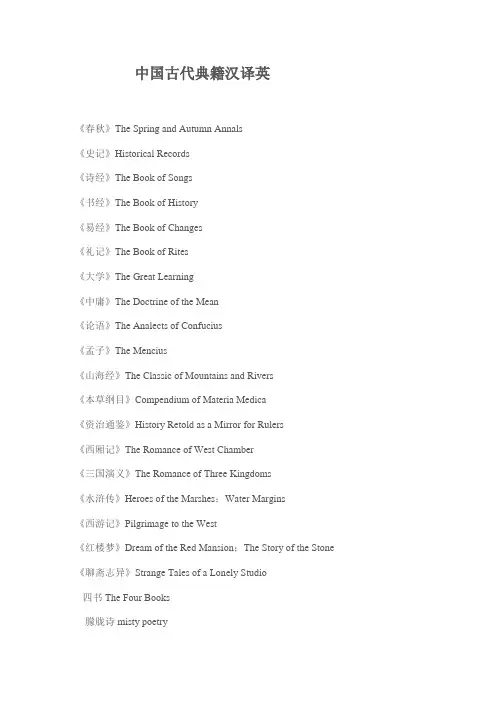
中国古代典籍汉译英《春秋》The Spring and Autumn Annals《史记》Historical Records《诗经》The Book of Songs《书经》The Book of History《易经》The Book of Changes《礼记》The Book of Rites《大学》The Great Learning《中庸》The Doctrine of the Mean《论语》The Analects of Confucius《孟子》The Mencius《山海经》The Classic of Mountains and Rivers《本草纲目》Compendium of Materia Medica《资治通鉴》History Retold as a Mirror for Rulers《西厢记》The Romance of West Chamber《三国演义》The Romance of Three Kingdoms《水浒传》Heroes of the Marshes;Water Margins《西游记》Pilgrimage to the West《红楼梦》Dream of the Red Mansion;The Story of the Stone 《聊斋志异》Strange Tales of a Lonely Studio四书The Four Books朦胧诗misty poetry三字经three-character scripture五言绝句five-character quatrain七言律诗seven-character octave八股文eight-part essay;stereotyped writing言情小说romantic fiction;sentimental novel武侠小说tales of roving knights;martial arts novel;a kung fu novel六艺:礼、乐、射、御、书、数six classical arts:rites,music,archery,riding,writing,arithmetic。
中国文化典籍英语翻译及赏析37:元曲杂剧《窦娥冤(节选)》
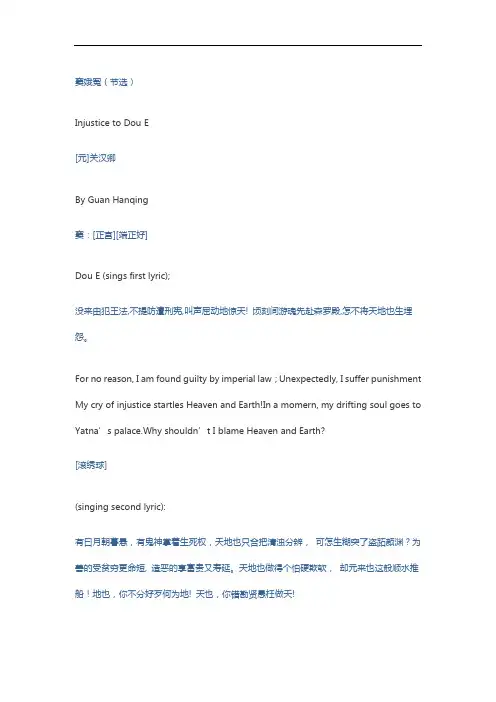
窦娥冤(节选)Injustice to Dou E[元]关汉卿By Guan Hanqing窦:[正宫][端正好]Dou E (sings first lyric);没来由犯王法,不提防遭刑宪,叫声屈动地惊天! 顷刻间游魂先赴森罗殿,怎不将天地也生埋怨。
For no reason, I am found guilty by imperial law;Unexpectedly, I suffer punishment My cry of injustice startles Heaven and Earth!In a momern, my drifting soul goes to Yatna’s palace.Why shouldn’t I blame Heaven and Earth?[滚绣球](singing second lyric):有曰月朝暮悬,有鬼神掌着生死权,夭地也只合把清浊分辨,可怎生糊突了盗跖颜渊?为善的受贫穷更命短, 造恶的享富贵又寿延。
天地也做得个怕硬欺软,却元来也这般顺水推船!地也,你不分好歹何为地! 天也,你错勘贤愚枉做夭!The sun and moon hang aloft by day and by night;Ghosts and spirits hold the power over lives and deaths.Heaven and Barth should distinguish the pure from the foul; But how they have mixed up Bandit Zhi and Yan Yuan!The good suffer poverty and short life;The wicked enjoy wealthy nobility, and long life. Even Heaven and Earth have come to fear the strong and oppress the weak. They, after all, only push the boats following the current.Oh Earth, as you fail to discriminate between good and evil.How can you function as Earth?Oh Heaven, in mistaking the sage and ibe fool,You are called Heaven in vain!。
中国文化典籍英译版本
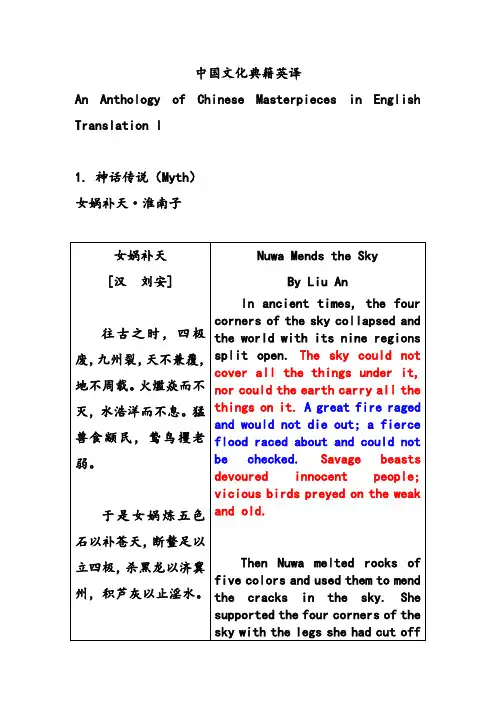
中国文化典籍英译
An Anthology of Chinese Masterpieces in English Translation I
1. 神话传说(Myth)
女娲补天·淮南子
2. 寓言(fable)画蛇添足·战国策
3. 诗经
(Book of Songs 或 Book of Odes )
中国的诗歌传统“诗六艺”:风、雅、颂、赋、比、兴,
始成于《诗经》。
风、雅、颂是诗歌分类,赋、比、兴是创作方法。
“风土之音曰风,朝廷之音曰雅,宗庙之音曰颂”。
4. 楚辞(Elegies of Chu, Songs of Chu, The Verse of Chu, Chu Ci)
离骚: Grief of Parting
5. 老子《道德经》(Lao Zi,The Way and Its Power)--- 道家(Taoism)
6. 庄子(Zhuang Tzu)
论语 [春秋] 孔子
The Analects / Lun Yu by Confucius
理解的困惑
Arthur Waley 亚瑟·威利Analects of Confucius Thomas Cleary 托马斯·柯立瑞Essential Confucius
唐诗
宋词
元曲
明清小说红楼梦。
中国文化典籍英译
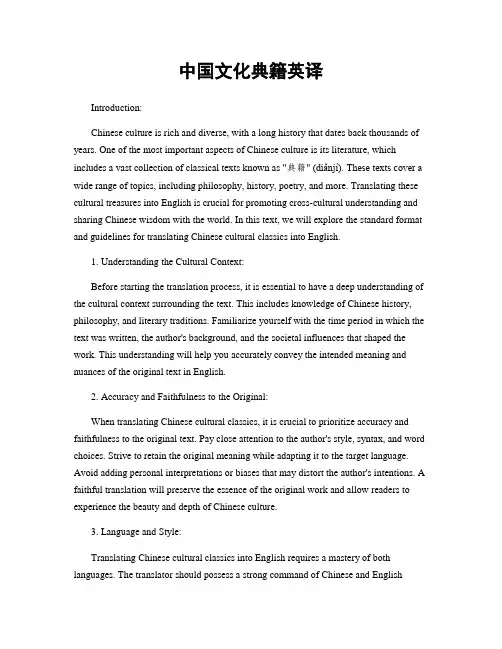
中国文化典籍英译Introduction:Chinese culture is rich and diverse, with a long history that dates back thousands of years. One of the most important aspects of Chinese culture is its literature, which includes a vast collection of classical texts known as "典籍" (diǎnjí). These texts cover a wide range of topics, including philosophy, history, poetry, and more. Translating these cultural treasures into English is crucial for promoting cross-cultural understanding and sharing Chinese wisdom with the world. In this text, we will explore the standard format and guidelines for translating Chinese cultural classics into English.1. Understanding the Cultural Context:Before starting the translation process, it is essential to have a deep understanding of the cultural context surrounding the text. This includes knowledge of Chinese history, philosophy, and literary traditions. Familiarize yourself with the time period in which the text was written, the author's background, and the societal influences that shaped the work. This understanding will help you accurately convey the intended meaning and nuances of the original text in English.2. Accuracy and Faithfulness to the Original:When translating Chinese cultural classics, it is crucial to prioritize accuracy and faithfulness to the original text. Pay close attention to the author's style, syntax, and word choices. Strive to retain the original meaning while adapting it to the target language. Avoid adding personal interpretations or biases that may distort the author's intentions. A faithful translation will preserve the essence of the original work and allow readers to experience the beauty and depth of Chinese culture.3. Language and Style:Translating Chinese cultural classics into English requires a mastery of both languages. The translator should possess a strong command of Chinese and Englishgrammar, vocabulary, and syntax. It is important to choose appropriate English equivalents for Chinese idioms, metaphors, and cultural references. Consider the target audience and aim for a style that is accessible and engaging. Maintain a balance between preserving the original text's literary qualities and ensuring readability for English-speaking readers.4. Footnotes and Annotations:Chinese cultural classics often contain references to historical events, figures, and cultural practices that may be unfamiliar to non-Chinese readers. To provide necessary context and enhance understanding, footnotes and annotations can be added to the translated text. Footnotes should be concise and provide explanations or additional information without interrupting the flow of the main text. Annotations can be used for more extensive explanations or discussions of specific cultural elements.5. Consistency and Coherence:Maintaining consistency and coherence throughout the translation is essential. Use consistent terminology for recurring concepts, names, and phrases. Pay attention to the logical flow of ideas and ensure that the translated text reads smoothly and coherently. Consider the overall structure of the text and how individual sections relate to each other.A well-structured translation will help readers navigate the complexities of the original work and fully appreciate its cultural significance.6. Editing and Proofreading:Once the translation is complete, thorough editing and proofreading are necessary to ensure accuracy and quality. Review the translated text for any grammatical errors, typos, or inconsistencies. Verify that the translation accurately reflects the original text's meaning and intent. Consider seeking feedback from native speakers or experts in the field to further refine the translation. A well-edited and polished translation will enhance its credibility and readability.Conclusion:Translating Chinese cultural classics into English is a challenging yet rewarding endeavor. It requires a deep understanding of both Chinese and English languages, as well as a profound knowledge of Chinese history and culture. By following the standard format and guidelines outlined above, translators can accurately convey the beauty and wisdom of Chinese literature to a global audience. Through these translations, we can bridge cultural gaps and foster a greater appreciation for the richness of Chinese culture.。
中国文化典籍英译
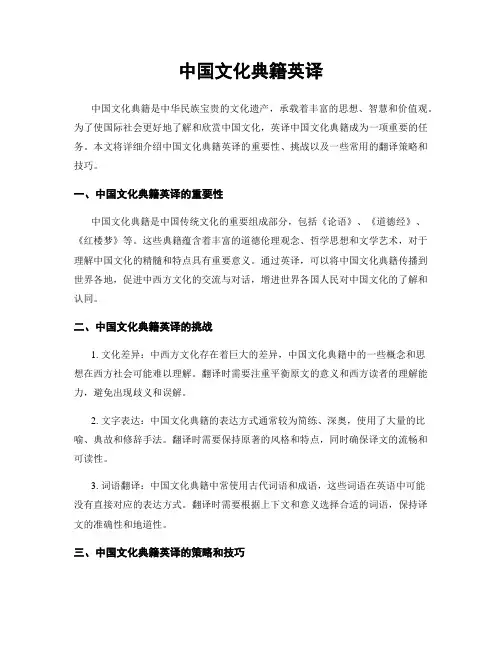
中国文化典籍英译中国文化典籍是中华民族宝贵的文化遗产,承载着丰富的思想、智慧和价值观。
为了使国际社会更好地了解和欣赏中国文化,英译中国文化典籍成为一项重要的任务。
本文将详细介绍中国文化典籍英译的重要性、挑战以及一些常用的翻译策略和技巧。
一、中国文化典籍英译的重要性中国文化典籍是中国传统文化的重要组成部分,包括《论语》、《道德经》、《红楼梦》等。
这些典籍蕴含着丰富的道德伦理观念、哲学思想和文学艺术,对于理解中国文化的精髓和特点具有重要意义。
通过英译,可以将中国文化典籍传播到世界各地,促进中西方文化的交流与对话,增进世界各国人民对中国文化的了解和认同。
二、中国文化典籍英译的挑战1. 文化差异:中西方文化存在着巨大的差异,中国文化典籍中的一些概念和思想在西方社会可能难以理解。
翻译时需要注重平衡原文的意义和西方读者的理解能力,避免出现歧义和误解。
2. 文字表达:中国文化典籍的表达方式通常较为简练、深奥,使用了大量的比喻、典故和修辞手法。
翻译时需要保持原著的风格和特点,同时确保译文的流畅和可读性。
3. 词语翻译:中国文化典籍中常使用古代词语和成语,这些词语在英语中可能没有直接对应的表达方式。
翻译时需要根据上下文和意义选择合适的词语,保持译文的准确性和地道性。
三、中国文化典籍英译的策略和技巧1. 理解原著:在进行翻译之前,首先要深入理解原著的内容和意义。
通过研读相关的历史、文化背景以及注释,对原著有一个全面的了解,避免在翻译过程中出现偏差和误解。
2. 保持风格:中国文化典籍通常有独特的风格和韵味,翻译时要尽量保持原著的风格特点。
可以使用一些英语修辞手法和表达方式,使译文更贴近原著的语言特点。
3. 灵活运用翻译技巧:在翻译过程中,可以灵活运用一些翻译技巧,如意译、加注释、使用脚注等。
这些技巧可以帮助读者更好地理解原著的意义和背景信息。
4. 校对和修改:翻译完成后,需要进行校对和修改。
可以请专业人士或母语为英语的人士进行审校,确保译文的准确性和流畅性。
24部中国名著的英文翻译
24部中国名著的英文翻译作者:佚名资源来源:大学生英语网点击数:573 更新时间:4/24/2008 《西游记》Pilgrimage to the West; Journey to the West《三国演义》The Romance of the Three Kingdoms《红楼梦》A Dream in Red Mansions (The Story of the Stone)《水浒传》Heroes of the Marshes; Water Margins《本草纲目》Compendium of Materia Medica《聊斋志异》Strange Tales of a Lonely Studio《论语》Analects of Confucius《山海经》the Classic of Mountains and Rivers《围城》A Surrounded City《西厢记》The Romance of West Chamber《资治通鉴》History as a Mirror《史记》Shi Ji/ Historical Records四书(《大学》、《中庸》、《论语》、《孟子》)The Four Books (The Great Learning, The Doctrine of the Mean,The Analects of Confucius, The Mencius)《阿Q正传》The True Story of Ah Q《春秋》Spring and Autumn Annals《论语》THE ANALCETS OF CONFUCIUS《诗经》the book of odes《世说新语》essays and criticism (shi shuo hsin yu)《封神演义》the legend of deification《金瓶梅》The golden lotus 《西厢记》The west chamber。
中国文化典籍英译
学号:42120446哈尔滨师范大学读书汇报论文题目《中国文化典籍英译》读书报告学生万晓安指导教师毛海燕年级 2012级专业英语笔译系别翻译硕士学院西语学院中国文化典籍英译中国文化典籍英译这本书主要包括绪论,正文和附录。
绪论包括两个部分:第一部分题为中国文化典籍和概论概括了典籍英译的理论定界和教学与研究的涉及范围;第二部分题为中国文化典籍英译的理论与技巧,讨论了文化典籍的文献分类,注释体例与翻译技巧。
中国文化典籍的定界,第一覆盖文史哲三科,兼顾儒释道三教,坚持开放与全球视野尝试打通与贯穿思路第二尝试以汉族文献为主,兼顾其他民族的文献的多元化格局,第三以统一的文明史理念,确定典籍选材的上下限,重点以及思路贯穿的途径。
中国文学文焕典籍的外译和英译状况,如何在认真而科学的评论中摆脱中国文化的本位论,破除民族的,语言的,文学的偏见仍然是个没有解决的问题,其次是价值合作方式问题。
绪论的第二部分中国文化典籍翻译的理论与技巧,首先讨论何为国学与国学之要点,中国文化典籍的整理与注释,如今分为经部史部子部和集部.关键术语的综合性注释作为译文的正文的必要补充,所谓的综合性注释,就是根据一个词在中国文化典籍中的基本含义和所指的意义,编写一个综合性的知识条目,说明他的来源,所指和扩充的含义,以及可能的引申义,以便定下一个基本的调子,提供一个基本的语义场作为在整个文本和其他地方这一词汇的基础..英文基本术语的对应于阐释明确有序,应考虑到语源知识尽量求的对应,基本定义,搭配关系,语境变异和系统的构建,句子需要明晰而行文晓畅,篇章层次可做必要的调整以求适合性,译文应关注不同文体和表达功能的体现,在知识可靠的基础上讲究艺术性和诗学功能。
本书的正文部分有二十四讲,基本囊括所有的中国文化典籍,第一讲上古神话,首先对神话进行概说,中国神话记载最早且最早见于战国至出汉,著名的《盘古开天辟地》《盘古化生万物》《夸父追日》等,选《女娲补天》作为例文翻译,其中很多中国元素,翻译的生动,女娲直译为Nuwa,九州和四极须加以解释,英文用the four corners of the sky and the world with its nine regions . 第二讲为先秦寓言,中国的寓言开始于先秦,但是社会动荡,列国争雄,诸子百家,各抒己见,或借传说故事讥他人之迂腐,寓言大兴。
24部中国名著的英文翻译
24部中国名著的英文翻译《西游记》Pilgrimage to the West; Journey to the West《三国演义》The Romance of the Three Kingdoms《红楼梦》A Dream in Red Mansions (The Story of the Stone)《水浒传》Heroes of the Marshes; Water Margins《本草纲目》Compendium of Materia Medica《聊斋志异》Strange Tales of a Lonely Studio《论语》Analects of Confucius《山海经》the Classic of Mountains and Rivers《围城》 A Surrounded City《西厢记》The Romance of West Chamber《资治通鉴》History as a Mirror《史记》Shi Ji/ Historical Records四书(《大学》、《中庸》、《论语》、《孟子》)The Four Books (The Great Learning, The Doctrine of the Mean,The Analects of Confucius, The Mencius)《阿Q正传》The True Story of Ah Q《春秋》Spring and Autumn Annals《论语》THE ANALCETS OF CONFUCIUS《诗经》the book of odes《世说新语》essays and criticism (shi shuo hsin yu)《封神演义》the legend of deification《金瓶梅》The golden lotus《西厢记》The west chamber。
浅析中国文化典籍英译的必要性
浅析中国文化典籍英译的必要性改革开放以来,伴随着科技的进步,国力的增强,中国逐渐成为全球第一大经济体,在全球治理体系中的重要作用愈发明显,无疑是世界上的政治强国和经济强国。
与之形成强烈对比的是,中国的文化软实力相对薄弱,在国际舆论环境中处于不利地位。
别具一格,自成体系的中国文化在目前以西方文化为主导的世界文化大背景下显得处境较为艰难。
同时,由于中西方文化的差异与冲突,中国威胁论和修昔底德陷阱等理论甚嚣尘上,不利于中国人类命运共同体等和谐理念的传播。
在这种背景下,响应领导人为外语人提出的“讲好中国故事”的任务,翻译中国文化典籍,让世界了解中国人的思想和精神,对改善中国在国际舆论中的不利地位,打破修昔底德陷阱的谬论,提升中国的文化软实力,传播中国关于国际关系和全球治理的先进理念有着重要战略意义。
从1807年第一本《论语》英译版 The Work of Confucius开始到目前为止现存11个英译版本,而其中只有辜鸿铭版,黄治中版和吴国珍版三版是中国人主导的翻译版本,其他8个版本均为外国学者所译。
由于中西方文化的差异和语言障碍,外国学者在进行《论语》英译特别是对文化负载词进行翻译的时候难免会存在理解的偏差和代入本国文化的现象,致使原文的语义无法被精准传达,《论语》所蕴含的精神内核也无法被外国人真正了解。
[1]“仁”是孔子思想的核心概念,是孔子全部政治主张的出发点的概念之一。
[2]因其因材施教的思想,孔子在《论语》一书中并未对“仁”做出明确的定义,但我们可以将其给出的不同答案大致归为两点:第一,爱人为仁,即应相互仁爱,建立伦理关系从而实现社会的稳定;第二,“克己复礼”为“仁”,即克制自己,使言行符合礼的规范。
理雅各(1815-1897)是苏格兰的汉学家,传教士,教育家和学者。
理雅各致力于人类的发展,他尽力学习和吸收包含中国经典文学在内的亚洲思想和文化,以传播这些新知识到基督教中。
显而易见,理雅各的翻译目的是了解中国文化以补全西方的基督文化,是以西方文话为出发点和立足点,因此他对《论语》进行翻译时无需深究语句的深层含义,仅需提取其中和基督文化相同点,进而大量采用了直译的翻译方法,对语篇中蕴含的文化负载词并没有进行过多的研究和注解。
- 1、下载文档前请自行甄别文档内容的完整性,平台不提供额外的编辑、内容补充、找答案等附加服务。
- 2、"仅部分预览"的文档,不可在线预览部分如存在完整性等问题,可反馈申请退款(可完整预览的文档不适用该条件!)。
- 3、如文档侵犯您的权益,请联系客服反馈,我们会尽快为您处理(人工客服工作时间:9:00-18:30)。
Here and there they can be caught;
The lovely girl with frail appeal,
He’ll befriend with zither and zeal.
The water plants are long and short,
Then Nuwa melted rocks of five colors and used them to mend the cracks in the sky. She supported the four corners of the sky with the legs she had cut off from a giant turtle. She killed the black dragon to save the people of Jizhou, and blocked the flood with the ashes of reeds.
Day and night he would her recall.
The first courtship comes to bay,
He longs for her wildly night and day.
The lingering longing grips him tight,
He tosses, unable to sleep at night.
苍天补,四极正,淫水涸,冀州平;狡虫死,颛民生,背方州,抱圆天。当此之时,禽兽虫蛇,无不匿其爪牙,藏其蛰毒,无有攫噬之心。
考其功烈,上际九天,下契黄垆,名声被后世,光辉熏万物。
Nuwa Mends the Sky
By Liu An
In ancient times, the four corners of the sky collapsed and the world with its nine regions split open.The sky could not cover all the things under it, nor could the earth carry all the things on it.A great fire raged and would not die out; a fierce flood raced about and could not be checked.Savage beasts devoured innocent people; vicious birds preyed on the weak and old.
Nuwa’s deeds benefited the heavens above and the earth below. Her name was remembered by later generations and her light shone on every creation.
Trans. by Ding Wangdao
Here and there they can be stored.
The lovely girl is slenderly tall,
With bells and drums he wins her after all.
Trans. by Gu Zhengkun
4.楚辞(Elegies of Chu,Songs of Chu,The Verse of Chu,Chu Ci)
The Man Who Draws a Snake and Adds Feet to It
By Liu Xiang
A native ofChuafter worshipping his ancestors gave his retainers a pot of wine. One of the retainers said, “It’s insufficient for all of us, but too much for one of us. I suggest, therefore, that we draw snakes on the ground, and the one who first finished drawing the snake will win the pot of wine.”
His-ho: Charioteer of the sun, generally represented as female.
Yen-tzǔ: Mountain of the far west where the sun goes beneath the earth.
5.老子《道德经》(Lao Zi,The Way and Its Power)---道家(Taoism)
诗经·国风
周南·关雎
关关雎鸠,在河之洲;
窈窕淑女,君子好逑。
参差荇菜,左右流之;
窈窕淑女,寤寐求之;
求之不得,寤寐思服;
悠哉游哉,辗转反侧。
参差荇菜,左右采之;
窈窕淑女,琴瑟友之。
参差荇菜,左右芼之;
窈窕淑女,钟鼓乐之。
Ospreys
Hark! The ospreys merrily call
On the islet off the river shore.
Trans. by David Hawkes
Ts’ang-wu: Name of the region where Ch’ung Hua (Shun) was buried.
Hsüan Pu, the “hanging garden”; in theMagicMountainof K’un-lun, which is God’s seat on earth and the doorway into heaven.
In the morning I started on my way fromTs’ang-wu;
In the evening I came to theGardenofParadise.
I wanted to stay a while in those fairy precincts,
But the swift-moving sun was dipping to the west.
Grieving that I was born in such an unlucky time.
I plucked soft lotus petals to wipe my welling tears,
That fell down in rivers and wet my coat front.
I knelt on my outspread skirts and poured my plaint out,
Ch’u Tzǔ: The Song of the South, An Ancient Chinese Anthology
By ChüYuan
Li Sao (On Encountering Sorrow) (excerpted)
Many a heavy sigh I heaved in despair,
离骚:Grief of Parting
楚辞
[战国屈原]
离骚(节选)
曾歔欷余郁悒兮,
哀朕时之不当。
揽茹蕙以掩涕兮,
沾余襟之浪浪。
跪敷衽以陈辞兮,
耿吾既得此中正。
驷玉虬以乘鹥兮,
溘埃风余上征。
朝发轫于苍梧兮,
夕余至乎县圃。
欲少留此灵锁兮,
日忽忽其将暮。
吾令羲和弭节兮,
望崦嵫而勿迫。
路曼曼其修远兮,
吾将上下而求索。
The girl is lovely and slenderly tall,
Whom the gentleman would adore.
The water plants are long and short,
Here and there they can be sought;
The lovely girl is slenderly tall,
And the righteousness within me was clearly manifest.
I yoked a team of jade dragons to a phoenix-figured car
And waited for the wind to come, to soar up on my journey.
2.寓言(fable)
楚有祠者,赐其舍人卮酒。舍人相谓曰:“数人饮之不足,一人饮之有余。请画地为蛇,先成者饮酒。”
一人蛇先成,引酒且饮之,乃左手执卮,右手画蛇,曰:“吾能为之足!”未成,一人之蛇成,夺其卮,曰:“蛇固无足,子安能为之足?”遂饮其酒。
为蛇足者,终亡其酒。
Thus the sky was mended,its four corners lifted, the flood tamed, Jizhou pacified, and harmful birds and beasts killed, and the innocent people were able to live on the square earth under the dome of the sky. It was a time when birds, beasts, insects and snakes no longer used their claws or teeth or poisonous stings, for they did not want to catch or eat weaker things.
中国文化典籍英译
An Anthology of Chinese Masterpieces in English Translation I
